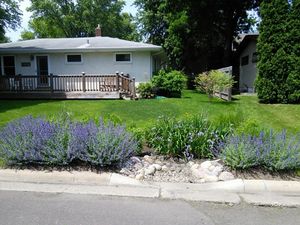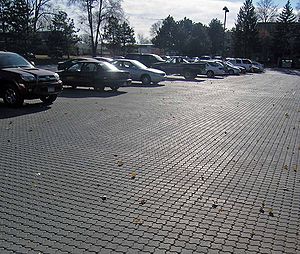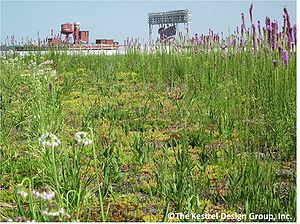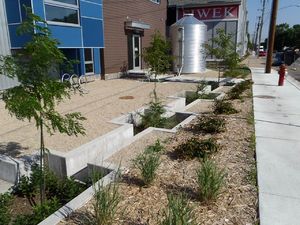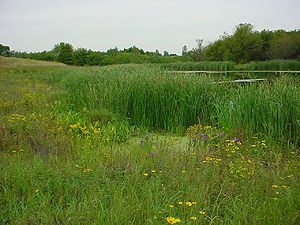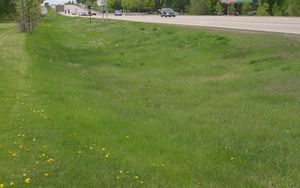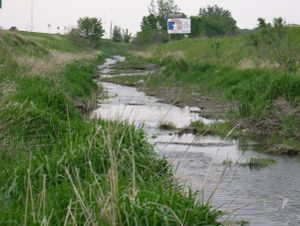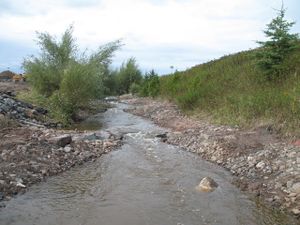
Difference between revisions of "Water quality benefits of Green Stormwater Infrastructure"
m |
|||
| (47 intermediate revisions by the same user not shown) | |||
| Line 1: | Line 1: | ||
| − | = | + | [[File:General information page image.png|right|100px|alt=image]] |
| − | + | [[File:Pdf image.png|100px|thumb|right|alt=pdf image|<font size=3>[https://stormwater.pca.state.mn.us/index.php?title=File:Water_quality_benefits_of_GSI.pdf Download pdf]</font size>]] | |
| − | |||
| − | = | + | This page provides information on the water quality benefits of <span title="Green stormwater infrastructure (GSI) describes practices that use natural systems (or engineered systems that mimic or use natural processes) to capture, clean, and infiltrate stormwater; shade and cool surfaces and buildings; reduce flooding, create wildlife habitat; and provide other services that improve environmental quality and communities’ quality of life. (City of Tucson)"> '''green stormwater infrastructure'''</span> (GSI) practices (<span title="One of many different structural or non–structural methods used to treat runoff"> '''best management practices'''</span>). The water quality benefit of a practice is defined by its ability to attenuate pollutants from stormwater runoff and prevent them from reaching <span title="A stream, river, lake, ocean, or other surface or groundwaters into which treated or untreated wastewater is discharged"> '''receiving waters'''</span>. All GSI practices provide water quality benefits since that is their primary function. |
| − | |||
| − | === | + | These benefits vary between each practice, primarily as a result of the mechanism by which pollutants are attenuated. |
| − | + | *Constructed ponds (<span title="A stormwater retention basin that includes a combination of permanent pool storage and extended detention storage above the permanent pool to provide additional water quality or rate control"> [https://stormwater.pca.state.mn.us/index.php?title=Stormwater_ponds '''wet ponds''']</span>) and wetlands (<span title="Stormwater wetlands are similar in design to stormwater ponds and mainly differ by their variety of water depths and associated vegetative complex."> '''[https://stormwater.pca.state.mn.us/index.php?title=Stormwater_wetlands stormwater wetlands]'''</span>) remove pollutants through <span title="Sedimentation is the process by which solids are removed from the water column by settling. Sedimentation practices include dry ponds, wet ponds, wet vaults, and other devices."> [https://stormwater.pca.state.mn.us/index.php?title=Stormwater_sedimentation_Best_Management_Practices '''sedimentation''']</span>. This removes medium- to large- diameter particles and pollutants attached to those particles, though effectiveness varies with design of the practice. See [[Calculating credits for stormwater ponds]]. For more information on sedimentation processes, [https://stormwaterbook.safl.umn.edu/sedimentation-practices link here]. | |
| + | *<span title="Filtration Best Management Practices (BMPs) treat urban stormwater runoff as it flows through a filtering medium, such as sand or an organic material. They are generally used on small drainage areas (5 acres or less) and are primarily designed for pollutant removal. They are effective at removing total suspended solids (TSS), particulate phosphorus, metals, and most organics. They are less effective for soluble pollutants such as dissolved phosphorus, chloride, and nitrate."> [https://stormwater.pca.state.mn.us/index.php?title=Stormwater_filtration_Best_Management_Practices '''Filtration''']</span> practices include bmps that have an <span title="An underground drain or trench with openings through which the water may percolate from the soil or ground above"> '''underdrain'''</span> (<span title="A bioretention practice having an underdrain. All water entering the practice is filtered through engineered media and filtered water is returned to the storm sewer system."> [https://stormwater.pca.state.mn.us/index.php?title=Bioretention '''biofiltration''']</span>, <span title="Permeable pavements allow stormwater runoff to filter through surface voids into an underlying stone reservoir for temporary storage and/or infiltration. The most commonly used permeable pavement surfaces are pervious concrete, porous asphalt, and permeable interlocking concrete pavers (PICP)."> '''[https://stormwater.pca.state.mn.us/index.php?title=Permeable_pavement permeable pavement]'''</span>, <span title="A tree trench, often known as a "vertical rain garden," is a system that consists of piping for water storage, structural soils and a tree."> '''[https://stormwater.pca.state.mn.us/index.php?title=Trees tree trench]'''</span>, <span title="Are configured as shallow, linear channels. They typically have vegetative cover such as turf or native perennial grasses"> [https://stormwater.pca.state.mn.us/index.php?title=Dry_swale_(Grass_swale) '''swales''']</span>, <span title="Green roofs consist of a series of layers that create an environment suitable for plant growth without damaging the underlying roof system. Green roofs create green space for public benefit, energy efficiency, and stormwater retention/ detention."> '''[https://stormwater.pca.state.mn.us/index.php?title=Green_roofs green roofs]'''</span>, and <span title="Filtration of stormwater through a sand filtering material whose purpose is to remove pollution from runoff"> '''[https://stormwater.pca.state.mn.us/index.php?title=Filtration media filters]'''</span>) or bmps that trap sediments from flowing water (<span title="Pretreatment vegetated filter strips are designed to provide sedimentation and screening (by vegetation) to treat stormwater runoff prior to entering a structural stormwater BMP. Pretreatment vegetated filter strips are especially effective at capturing excess sediment in stormwater runoff by settling solids. Pretreatment vegetated filter strips provide limited (due to size) volume reduction, peak flow reduction, infiltration, and biological treatment. Stormwater management processes not provided in pretreatment vegetated filter strips include filtration and sorption."> [https://stormwater.pca.state.mn.us/index.php?title=Overview_for_pretreatment_vegetated_filter_strips '''vegetated filter strips''']</span>, swales, green roofs). | ||
| + | *<span title="Infiltration Best Management Practices (BMPs) treat urban stormwater runoff as it flows through a filtering medium and into underlying soil, where it may eventually percolate into groundwater. The filtering media is typically coarse-textured and may contain organic material, as in the case of bioinfiltration BMPs."> [https://stormwater.pca.state.mn.us/index.php?title=Stormwater_infiltration_Best_Management_Practices '''Infiltration''']</span> practices remove pollutants by capturing runoff and infiltrating it vertically into underlying soil, the <span title="The vadose zone is the variably saturated zone between the ground surface and the permanent water table of the groundwater."> '''vadose zone'''</span>, and groundwater. Attenuation occurs primarily through adsorption and filtering, though dilution in groundwater may also be a mechanism for reducing pollutant concentrations. | ||
| − | === | + | {| class="wikitable" style="float:right; margin-left: 10px; width:500px;" |
| − | + | |- | |
| + | ! Practice !! Water quality benefit !! Notes | ||
| + | |- | ||
| + | | Bioretention || <font size=6><center>●</center></font size> || Infiltration is most effective; potential phosphorus leaching in filtration practices | ||
| + | |- | ||
| + | | Tree trench and tree box || <font size=6><center>●</center></font size> || Infiltration is most effective; potential phosphorus leaching in filtration practices | ||
| + | |- | ||
| + | | Green roof || <font size=4><center>◔</center></font size> || Potential phosphorus leaching | ||
| + | |- | ||
| + | | Vegetated swale || <font size=4><center>◔</center></font size> || Infiltration is most effective; less effective for dissolved pollutants | ||
| + | |- | ||
| + | | Vegetated filter strip || <font size=4><center>◔</center></font size> || Removes solids; less effective for dissolved pollutants | ||
| + | |- | ||
| + | | Permeable pavement || <font size=4><center>◕</center></font size> || Infiltration is most effective | ||
| + | |- | ||
| + | | Constructed wetland</td> || <font size=4><center>◑</center></font size> || Removes solids; less effective for dissolved pollutants | ||
| + | |- | ||
| + | |Rainwater harvesting || <font size=4><center>◕</center></font size> || Can be used on low permeability soils | ||
| + | |- | ||
| + | | colspan="3" | Level of benefit: ◯ - none; <font size=4>◔</font size>; - small; <font size=4>◑</font size> - moderate; <font size=4>◕</font size> - large; <font size=6>●</font size> - very high | ||
| + | |} | ||
| + | </table> | ||
| − | == | + | ==Green infrastructure and multiple benefits== |
| − | + | <span title="Green stormwater infrastructure is designed to mimic nature and capture rainwater where it falls. Green infrastructure reduces and treats stormwater at its source while while also providing multiple community benefits such as improvements in water quality, reduced flooding, habitat, carbon capture, etc."> '''Green infrastructure'''</span> (GI) encompasses a wide array of practices, including stormwater management. <span title="Green stormwater infrastructure (GSI) describes practices that use natural systems (or engineered systems that mimic or use natural processes) to capture, clean, and infiltrate stormwater; shade and cool surfaces and buildings; reduce flooding, create wildlife habitat; and provide other services that improve environmental quality and communities’ quality of life. (City of Tucson)"> '''Green stormwater infrastructure'''</span> (GSI) encompasses a variety of practices primarily designed for managing stormwater runoff but that provide additional benefits such as habitat or aesthetic value. | |
| − | + | There is no universal definition of GI or GSI ([https://stormwater.pca.state.mn.us/index.php?title=Green_infrastructure_and_green_stormwater_infrastructure_terminology link here for more information]). Consequently, the terms are often interchanged, leading to confusion and misinterpretation. GSI practices are designed to function as stormwater practices first (e.g. flood control, treatment of runoff, volume control), but they can provide additional benefits. Though designed for stormwater function, GSI practices, where appropriate, should be designed to deliver multiple benefits (often termed "multiple stacked benefits". For more information on green infrastructure, ecosystem services, and sustainability, link to [[Multiple benefits of green infrastructure and role of green infrastructure in sustainability and ecosystem services]]. | |
| − | |||
| − | == | + | ==Pollutant removal percentages for bmps== |
| − | + | The adjacent table provides a summary of estimated pollutant removal for stormwater bmps. However, pollutant removal is a function of many factors, including design, construction, and maintenance of the BMP; quality of incoming stormwater; time of year; rainfall and watershed characteristics; and so on. The user is encouraged to read the section called [https://stormwater.pca.state.mn.us/index.php?title=Information_on_pollutant_removal_by_BMPs#Factors_affecting_pollutant_removal Factors affecting pollutant removal]. | |
| − | : | + | {{:Median pollutant removal percentages for BMPs}} |
| − | |||
| − | == | + | ==Bioretention== |
| − | + | [[file:RG pic1.jpg|thumb|300px|alt=photo of a rain garden|<font size=3>A rain garden in a residential development. Photo courtesy of Katherine Sullivan.</font size>]] | |
| − | + | Bioretention is an excellent stormwater treatment practice due to the variety of pollutant removal mechanisms, including vegetative filtering, settling, evaporation, infiltration, <span title="The loss of water as vapor from plants at their surfaces, primarily through stomata."> '''transpiration'''</span>, biological and microbiological uptake, and soil adsorption. Bioretention can be designed as an effective [https://stormwater.pca.state.mn.us/index.php?title=Stormwater_infiltration_Best_Management_Practices infiltration] / recharge practice, particularly when parent soils have high permeability (> ~ 0.3 inches per hour). Bioretention designed for infiltration (<span title="A bioretention practice in which no underdrain is used. All water entering the bioinfiltration practice infiltrates or evapotranspires."> '''bioinfiltration'''</span>) removes 100 percent of pollutants for the portion of runoff water that is infiltrated, although there [https://stormwater.pca.state.mn.us/index.php?title=Surface_water_and_groundwater_quality_impacts_from_stormwater_infiltration may be impacts to shallow groundwater]. Bioretention designed as filtration (<span title="A bioretention practice having an underdrain. All water entering the practice is filtered through engineered media and filtered water is returned to the storm sewer system."> [https://stormwater.pca.state.mn.us/index.php?title=Bioretention '''biofiltration''']</span>) employs <span title="Engineered media is a mixture of sand, fines (silt, clay), and organic matter utilized in stormwater practices, most frequently in bioretention practices. The media is typically designed to have a rapid infiltration rate, attenuate pollutants, and allow for plant growth."> [https://stormwater.pca.state.mn.us/index.php?title=Design_criteria_for_bioretention#Materials_specifications_-_filter_media '''engineered media''']</span> that is effective at removing solids, most metals, and most organic chemicals. Removal of phosphorus depends on the media ([https://stormwater.pca.state.mn.us/index.php?title=Design_criteria_for_bioretention#Addressing_phosphorus_leaching_concerns_with_media_mixes link here]). | |
| − | |||
| − | |||
| − | + | The following design considerations can improve the water quality function of bioretention practices. | |
| − | + | *Maximize infiltration by designing with the maximum ponded depth that can be infiltrated in 48 hours, up to 1.5 feet (to protect vegetation). Where space allows, surface area can also be increased. Utilize multiple bioretention practices in series. On lower permeability soils where an underdrain is used, raise the underdrain to the maximum extent possible, allowing water stored in the bioretention media below the underdrain to drain in 48 hours. Use an upturned elbow in underdrained systems. | |
| + | *For bioinfiltration (bioretention without an underdrain), use a high organic matter media to maximize pollutant removal | ||
| + | *For biofiltration (bioretention with an underdrain), use a [https://stormwater.pca.state.mn.us/index.php?title=Design_criteria_for_bioretention#Addressing_phosphorus_leaching_concerns_with_media_mixes media mix that does not export phosphorus] or [https://stormwater.pca.state.mn.us/index.php?title=Soil_amendments_to_enhance_phosphorus_sorption use an amendment to attenuate phosphorus]. | ||
| − | ===References=== | + | See [[Calculating credits for bioretention]] |
| − | + | ||
| − | + | ==Tree Trench== | |
| − | + | [[File:Central corridor final.jpg|thumb|300px|alt=photo for tree trench system, Central Corridor Light rail project|<font size=3>Photo of the completed tree system for the Central Corridor Light Rail Transit project, St. Paul, Minnesota. Image courtesy of the [http://www.capitolregionwd.org/ Capitol Region Watershed District].</font size>]] | |
| − | + | ||
| − | + | Tree trenches and tree boxes are a type of bioretention practice and are therefore an excellent stormwater treatment practice due to the variety of pollutant removal mechanisms including vegetative <span title="Filtration Best Management Practices (BMPs) treat urban stormwater runoff as it flows through a filtering medium, such as sand or an organic material. They are generally used on small drainage areas (5 acres or less) and are primarily designed for pollutant removal. They are effective at removing total suspended solids (TSS), particulate phosphorus, metals, and most organics. They are less effective for soluble pollutants such as dissolved phosphorus, chloride, and nitrate."> [https://stormwater.pca.state.mn.us/index.php?title=Filtration '''filtering''']</span>, settling, evaporation, <span title="Infiltration Best Management Practices (BMPs) treat urban stormwater runoff as it flows through a filtering medium and into underlying soil, where it may eventually percolate into groundwater. The filtering media is typically coarse-textured and may contain organic material, as in the case of bioinfiltration BMPs."> [https://stormwater.pca.state.mn.us/index.php?title=Stormwater_infiltration_Best_Management_Practices '''infiltration''']</span>, <span title="The loss of water as vapor from plants at their surfaces, primarily through stomata."> '''transpiration'''</span>, biological and microbiological uptake, and soil adsorption. Tree trenches and tree boxes can be designed as an effective infiltration / recharge practice, particularly when parent soils have high permeability (> ~ 0.3 inches per hour). | |
| − | + | ||
| − | + | The following design considerations can improve the water quality benefits of tree trenches. | |
| − | + | *Maximize infiltration by designing with the maximum ponded depth that can be infiltrated in 48 hours, up to 1.5 feet (to protect vegetation). Where space allows, surface area can also be increased. | |
| − | + | *Utilize multiple bioretention practices in series. | |
| + | *On lower permeability soils where an underdrain is used, raise the underdrain to the maximum extent possible, allowing water stored in the <span title="Engineered media is a mixture of sand, fines (silt, clay), and organic matter utilized in stormwater practices, most frequently in bioretention practices. The media is typically designed to have a rapid infiltration rate, attenuate pollutants, and allow for plant growth."> [https://stormwater.pca.state.mn.us/index.php?title=Design_criteria_for_bioretention#Materials_specifications_-_filter_media '''engineered media''']</span> below the underdrain to drain in 48 hours. Use an upturned elbow in underdrained systems. | ||
| + | *For <span title="A bioretention practice in which no underdrain is used. All water entering the bioinfiltration practice infiltrates or evapotranspires."> '''bioinfiltration'''</span> (bioretention without an underdrain), use a high organic matter media to maximize pollutant removal. | ||
| + | *For <span title="A bioretention practice having an underdrain. All water entering the practice is filtered through engineered media and filtered water is returned to the storm sewer system."> [https://stormwater.pca.state.mn.us/index.php?title=Bioretention '''biofiltration''']</span> (bioretention with an underdrain), use a [https://stormwater.pca.state.mn.us/index.php?title=Design_criteria_for_bioretention#Addressing_phosphorus_leaching_concerns_with_media_mixes media mix that does not export phosphorus] or [https://stormwater.pca.state.mn.us/index.php?title=Soil_amendments_to_enhance_phosphorus_sorption use an amendment to attenuate phosphorus]. | ||
| + | |||
| + | See [[Calculating credits for tree trenches and tree boxes]] | ||
| + | |||
| + | ==Permeable Pavement== | ||
| + | [[File:Univ of MN PICP Photograph.jpg|thumb|300px|alt=a photo illustrating porous concrete|<font size=3>Example of a new retrofit permeable parking lot at the University of Minnesota</font size>]] | ||
| + | |||
| + | Permeable pavement reduces the concentration of some pollutants either physically (by trapping it in the pavement or soil), chemically (bacteria and other microbes can break down and utilize some pollutants), or biologically (plants that grow in-between some types of pavers can trap and store pollutants)([https://stormwater.pca.state.mn.us/index.php?title=Green_Infrastructure_References#Water_quality_benefits_of_Green_SW_Infrastructure_Page 5]). Permeable pavement functioning as an infiltration practice (no underdrain) effectively treats most pollutants, including dissolved pollutants. When an underdrain is employed, permeable pavement is effective at removing solids and pollutants attached to those solids. Additionally, permeable pavements can reduce the need for road salt. | ||
| + | |||
| + | The following design considerations may improve the water quality benefits of permeable pavement. | ||
| + | *Ensure the subgrade is flat. Since roads are typically sloped, utilize terracing in the subgrade to achieve flat slopes. See [https://files.nc.gov/ncdeq/Energy%20Mineral%20and%20Land%20Resources/Stormwater/BMP%20Manual/C-5%20%20Permeable%20Pavement%2004-06-17.pdf page 5 of the North Carolina design guidance]. | ||
| + | *Incorporate signage into the design to ensure maintenance activities do not affect the infiltration properties of the pavement. | ||
| + | *Design to maximize retention time and prevent short-circuiting. Storage may be increased by use of geotextile subgrades. An example is presented by Nnadi et al, (2014). | ||
| + | *Plan for the expected loading on the permeable pavement and ensure capabilities and reduce compaction or clogging | ||
| + | *Use in conjunction with other treatments to establish a treatment train or reuse water on site | ||
| + | *Some research has been conducted into use of geotextiles and other amendments for enhancing water quality treatment. See Ostrom and Davis (2019) and Nnadi et al. (2014). | ||
| + | |||
| + | See [[Calculating credits for permeable pavement]] | ||
| + | |||
| + | ==Green Roofs== | ||
| + | [[File:Target Center Arena Green Roof 2, Minneapolis, MN.jpg|300px|thumb|alt=image of target center green roof, Minneapolis, MN|<font size=3>Vegetation on the Target Center Arena green roof. vegetation consisted of a pregrown Sedum mat supplemented with 22 species of plugs and 16 species of seed native to Minnesota’s bedrock bluff prairies. Image Courtesy of The Kestrel Design Group, Inc.</font size>]] | ||
| + | |||
| + | Green roofs provide stormwater treatment benefits, but because pollutant concentrations are generally low, these benefits are limited. Pollutant removal mechanisms include filtering, evaporation, <span title="The loss of water as vapor from plants at their surfaces, primarily through stomata."> '''transpiration'''</span>, biological and microbiological uptake, and soil adsorption. | ||
| + | |||
| + | Green roofs employ <span title="Engineered media is a mixture of sand, fines (silt, clay), and organic matter utilized in stormwater practices, most frequently in bioretention practices. The media is typically designed to have a rapid infiltration rate, attenuate pollutants, and allow for plant growth."> [https://stormwater.pca.state.mn.us/index.php?title=Design_criteria_for_bioretention#Materials_specifications_-_filter_media '''engineered media''']</span> that is effective at removing solids, most metals, and most organic chemicals. Green roofs are generally not effective at retaining phosphorus because of the organic matter content in the media. They therefore are likely to lose phosphorus during the first years after establishment, but loss may gradually diminish over time. Use of low organic matter media, media that does not leach phosphorus (e.g. peat), or amendments (e.g. iron filings) may minimize or eliminate phosphorus losses from green roofs. | ||
| + | |||
| + | See [[Calculating credits for green roofs]] and [https://stormwater.pca.state.mn.us/index.php?title=File:Green_roof_pollutant_removal.docx this technical support document]. | ||
| + | |||
| + | ==Water Re-use and Harvesting== | ||
| + | [[File:Cistern located at Mississippi Watershed Management Organization 2.jpg|300px|left|alt=This picture shows a cistern located at Mississippi Watershed Management Organization|<font size=3>Cistern located at Mississippi Watershed Management Organization. Photo by MWMO Staff.</font size>]] | ||
| + | |||
| + | Water re-use and water harvesting facilities can help improve water quality by capturing stormwater runoff and reducing offsite discharges into the storm sewer system and nearby water resources. The nature of stormwater re-use facilities varies widely, thus there is great variability in their effectiveness to remove storm water pollutants. Most water re-use projects have been developed to meet non-potable water demands, such as agriculture, landscape, public parks, irrigation, etc. In these cases, the captured stormwater is removed from the waste stream and prevented from reaching receiving waters. Water re-use systems can be used to create or enhance wetlands and riparian (stream) habitats for streams that have been impaired or dried from water diversion, thus enhancing the water quality benefits of these other practices. | ||
| + | |||
| + | The following design considerations may enhance the water quality benefits of harvest and reuse systems. | ||
| + | *The designer should consider the project site pollutant sources during design and determine if additional stormwater treatment measures are required for use, what level of pretreatment is needed, and whether first flush diverters are appropriate. For more information on pollutant sources and pretreatment needs see [[Water quality considerations for stormwater and rainwater harvest and use/reuse]]. Also see information on [[Pretreatment]]. | ||
| + | *The designer should consider first flush diverters in the collection system design to bypass high pollution loads during snowmelt or pollutant laden events when necessary to meet the requirements of the water use. However, first flush diverters should be utilized with caution (Blue Mountain, 2022; Savou, 2022). | ||
| + | *Designer should place the appropriate settlement and solid removal procedures in the treatment train to prevent their entry into the reuse containment system | ||
| + | *Design the site container to maximize capture and storage of runoff and prevent short-circuiting during rainfall events. See [[Determining the appropriate storage size for a stormwater and rainwater harvest and use/reuse system]] and [[Estimating the water balance for a stormwater and rainwater harvest and use/reuse site]]. | ||
| + | |||
| + | See [[Calculating credits for stormwater and rainwater harvest and use/reuse]] | ||
| + | |||
| + | ==Constructed Ponds and Wetlands== | ||
| + | [[File: Photo 2 of stormwater wetland.jpg|right|thumb|300 px|alt=This photo shows a an example of a stormwater wetland|<font size=3>Example of a stormwater wetland in a largely undeveloped area.</font size>]] | ||
| + | |||
| + | Pollutants are removed from stormwater <span title="The draining away of water (or substances carried in it) from the surface of an area of land, a building or structure, etc."> '''runoff'''</span> in a wetland through uptake by wetland vegetation and biota (algae, bacterial), <span title="Vegetative filtering is the removal of sediment, nutrients, or pollutants by plant structures"> '''vegetative filtering'''</span>, <span title="The ability of the solid surfaces of soil to take up various substances with which they are in contact.> '''soil adsorption'''</span>, and gravitational settling in the slow moving marsh flow. <span title="Volatilization is the process whereby a dissolved sample is vaporised"> '''Volatilization'''</span> and chemical activity can also occur, breaking down and assimilating a number of other stormwater contaminants such as <span title="A compound of hydrogen and carbon, such as any of those which are the chief components of petroleum and natural gas."> '''hydrocarbons'''</span>. Wetlands effectively remove solids and pollutants associated with solids. They are only moderately effective at removing nitrogen and phosphorus. Some designs or poorly designed and maintained wetlands may export phosphorus. For information on pollutant removal for stormwater wetlands, link to [[Calculating credits for stormwater wetlands]]. | ||
| + | |||
| + | '''CAUTION''': Using constructed wetlands for extensive water quality treatment may impair the wetland for other functions, such as habitat. | ||
| + | |||
| + | The following design considerations may improve the water quality benefits of constructed ponds and wetlands (Balderas-Guzman et al., 2018) | ||
| + | *Distribute constructed wetlands systemically throughout a watershed to increase potential for delivering networked benefits | ||
| + | *Design to maximize retention time and prevent short-circuiting | ||
| + | *Create ecological diversity within the wetland to expose water to a variety of conditions where different treatment processes can take place | ||
| + | *Create shallow zones were water will come into contact with plant roots and microbes and deeper zones where anaerobic processes can take place | ||
| + | *Utilize a length to width ratio of 20:1 | ||
| + | *Construct multiple wetland cells | ||
| + | *Ensure adequate <span title="Pretreatment reduces maintenance and prolongs the lifespan of structural stormwater BMPs by removing trash, debris, organic materials, coarse sediments, and associated pollutants prior to entering structural stormwater BMPs. Implementing pretreatment devices also improves aesthetics by capturing debris in focused or hidden areas. Pretreatment practices include settling devices, screens, and pretreatment vegetated filter strips."> [https://stormwater.pca.state.mn.us/index.php?title=Pretreatment '''pretreatment''']</span> to minimize pollutant loading that might impair other benefits, such as habitat | ||
| + | |||
| + | See [[Calculating credits for stormwater wetlands]] | ||
| + | |||
| + | ==Swale with Check Dam (with and without underdrain)== | ||
| + | [[File:Dry swale.jpg|300 px|thumb|alt=photo of a dry swale|<font size=3>Photo of a dry swale. Courtesy of Limnotech.</font size>]] | ||
| + | [[File:Wet swale.jpg|300 px|thumb|alt=photo of a wet swale|<font size=3>Photo of a wet swale. Courtesy of Limnotech.</font size>]] | ||
| + | [[File:Step pool.jpg|300px|thumb|alt=image of step pool|<font size=3>Stormwater step pool. Courtesy of Limnotech.</font size>]] | ||
| + | |||
| + | Water quality benefits of swales depends on the type of swale (Jamil, 2009). See [[Terminology for swales]]. | ||
| + | *Dry swales: Water quality benefits of dry swales primarily depend on the presence or absence of check dams and underlying soils. When impermeable check dams are used on permeable soils (hydrologic group A or B soils), swales act as infiltration practices and provide water quality benefits similar to other infiltration practices. If check dams are permeable, swales provide water quality treatment through sedimentation processes. When check dams are absent, swales may provide some filtration of water by vegetation and some infiltration if underlying soils are permeable. | ||
| + | *Wet swales: Wet swales are generally ineffective for water quality treatment. | ||
| + | *Step pools: Similar to dry swales, step pools can provide effective water quality treatment when impermeable check dams are employed on permeable soils. | ||
| + | |||
| + | The following design considerations may improve the water quality benefits of swales. (Guzman et al., 2018; (Stagge et al., 2012; Purvis et al., 2018). | ||
| + | *If underlying soils are permeable (HSG A or B), incorporate impermeable check dams into the design to promote infiltration. For wet swales incorporate permeable check dams to slow water movement and enhance filtration of solids. | ||
| + | *For infiltration swales (swales without an underdrain), use a high organic matter media to maximize pollutant removal | ||
| + | *Utilize side slopes as pretreatment by incorporating appropriate vegetation and geometry (e.g. dense grass, increased surface roughness, gentler and longer slopes) | ||
| + | *Select vegetation with dense root systems | ||
| + | *For swales (swales with an underdrain), use a [https://stormwater.pca.state.mn.us/index.php?title=Design_criteria_for_bioretention#Addressing_phosphorus_leaching_concerns_with_media_mixes media mix that does not export phosphorus] or [https://stormwater.pca.state.mn.us/index.php?title=Soil_amendments_to_enhance_phosphorus_sorption use an amendment to attenuate phosphorus]. | ||
| + | |||
| + | See [[Calculating credits for dry swale (grass swale)]], [[Calculating credits for wet swale (wetland channel)]], and [[Calculating credits for high-gradient stormwater step-pool swale]]. | ||
| + | |||
| + | ==Infiltration practices== | ||
| + | Several practices can be designed as either filtration or infiltration practices. These include bioretention, permeable pavement, and tree trenches without underdrains, swales with impermeable check dams, and harvest and reuse systems. These practices are discussed above. If the practice is designed to infiltrate stormwater runoff, water quality benefits of the practices are excellent as infiltration removes 100 percent of the pollutants captured by the practice. However, infiltration practices should be designed to avoid potential groundwater contamination, such as infiltration practices located on coarse-textured soils with groundwater tables near the land surface, or infiltrating runoff with high concentrations of potentially mobile pollutants. See the constraints section [https://stormwater.pca.state.mn.us/index.php?title=Stormwater_infiltration on this page]. | ||
| + | |||
| + | ==References== | ||
| + | *Balderas-Guzman, C., H. Nepf, and A. M. Berger. 2018. [https://lcau.mit.edu/sites/lcau.mit.edu/files/attachments/project/Design%20Guidelines_Web%20Version.pdf Design Guidelines for Urban Stormwater Wetlands]. | ||
| + | *Berndtsson, J.C., L. Bengtsson, and K. Jinno. 2009. [https://www.sciencedirect.com/science/article/pii/S0925857408002024 Runoff water quality from intensive and extensive vegetated roofs]. Ecological Engineering, Volume 35, Issue 3, Pages 369-380. | ||
| + | *Blue Mountain. [https://rainharvesting.com.au/field-notes/articles/rain-harvesting/the-benefits-of-using-first-flush-diverters/#:~:text=First%20flush%20diverters%20are%20a,first%20initial%20millimetres%20of%20rain. Why use First Flush Diverters?]. Accessed November 15, 2022. | ||
| + | *Davis, A.P. 2007. ''Performance of Bioretention: Water Quality''. Environmental Engineering ScienceVol. 24, No. 8. https://doi.org/10.1089/ees.2006.0190. | ||
| + | *Guzman, C.B., S.R. Cohen, M.L. Machado, and T. Swingle. 2018. ''Island topographies to reduce short-circuiting in stormwater detention ponds and treatment wetlands''. Ecological Engineering 117:182. DOI:10.1016/j.ecoleng.2018.02.020 | ||
| + | *Jamil, N.E.E. 2009. [https://drum.lib.umd.edu/bitstream/handle/1903/9237/Jamil_umd_0117N_10107.pdf?sequence=1&isAllowed=y FIELD EVALUATION OF HYDROLOGIC AND WATER QUALITY BENEFITS OF GRASS SWALES WITH CHECK DAMS FOR MANAGING HIGHWAY RUNOFF]. M.S. Thesis, University of Maryland. | ||
| + | *OConnor, T., P. Culligan, T. Carson, S. Gaffin, R. Gibson, R. Hakimdavar, D. Hsueh, N. Hunter, D. Marasco, AND W. McGillis. 2014. [https://cfpub.epa.gov/si/si_public_record_report.cfm?dirEntryId=291092 Evaluation of Green Roof Water Quantity and Quality Performance in an Urban Climate]. U.S. EPA Office of Research and Development, Washington, DC, EPA/600/R-14/180. | ||
| + | *Purvis, R.A., R.J. Winston, W.F. Hunt, B. Lipscomb, K. Narayanaswamy, A. McDaniel, M.S. Lauffer, and S. Libes. 2018. [https://www.mdpi.com/2073-4441/10/2/134 Evaluating the Water Quality Benefits of a Bioswale in Brunswick County, North Carolina (NC), USA]. Water 2018, 10(2), 134; https://doi.org/10.3390/w10020134. | ||
| + | *United States EPA. 2013. [https://www.epa.gov/sites/production/files/2015-11/documents/stormwater2streettrees.pdf Stormwater to Street Trees: Engineering Urban Forests for Stormwater Management]. EPA 841-B-13-001. | ||
| + | *Savou, J. [https://www.bluebarrelsystems.com/blog/first-flush-diverter/ To First Flush, or not to First Flush]. BlueBarrel Rainwater Catchment Systems. | ||
| + | *Selbig, B.R. 2019. [https://www.usgs.gov/science/evaluating-potential-benefits-permeable-pavement-quantity-and-quality-stormwater-runoff?qt-science_center_objects=0#qt-science_center_objects Evaluating the potential benefits of permeable pavement on the quantity and quality of stormwater runoff]. | ||
| + | *Stagge, J.H., A.P. Davis, E. Jamil, and H. Kim. 2012. [https://www.sciencedirect.com/science/article/pii/S0043135412001406?casa_token=1FRCoY8pajoAAAAA:8ZAQDNwojU4fZjUJfQypQQLGR4bdrySQYd3BOUQ8Z0CNqC-0X1R8EymNULGP0cxt2-Wj4lVWhnQ Performance of grass swales for improving water quality from highway runoff]. Water Research, Volume 46, Issue 20, Pages 6731-6742. https://doi.org/10.1016/j.watres.2012.02.037. | ||
| + | *United States EPA. [https://www.epa.gov/soakuptherain/soak-rain-permeable-pavement Soak up the Rain - Permeable Pavement]. Website accessed November 16, 2022. | ||
| + | *United States EPA. 2009. [https://nepis.epa.gov/Exe/ZyNET.exe/200044AG.TXT?ZyActionD=ZyDocument&Client=EPA&Index=1995+Thru+1999&Docs=&Query=&Time=&EndTime=&SearchMethod=1&TocRestrict=n&Toc=&TocEntry=&QField=&QFieldYear=&QFieldMonth=&QFieldDay=&IntQFieldOp=0&ExtQFieldOp=0&XmlQuery=&File=D%3A%5Czyfiles%5CIndex%20Data%5C95thru99%5CTxt%5C00000015%5C200044AG.txt&User=ANONYMOUS&Password=anonymous&SortMethod=h%7C-&MaximumDocuments=1&FuzzyDegree=0&ImageQuality=r75g8/r75g8/x150y150g16/i425&Display=hpfr&DefSeekPage=x&SearchBack=ZyActionL&Back=ZyActionS&BackDesc=Results%20page&MaximumPages=1&ZyEntry=1&SeekPage=x&ZyPURL# Storm Water Technology Fact Sheet - Sand Filters]. EPA 832-F-99-007. | ||
| + | |||
| + | [[Category:Level 2 - Management/Green infrastructure]] | ||
Latest revision as of 17:35, 5 December 2022
This page provides information on the water quality benefits of green stormwater infrastructure (GSI) practices ( best management practices). The water quality benefit of a practice is defined by its ability to attenuate pollutants from stormwater runoff and prevent them from reaching receiving waters. All GSI practices provide water quality benefits since that is their primary function.
These benefits vary between each practice, primarily as a result of the mechanism by which pollutants are attenuated.
- Constructed ponds ( wet ponds) and wetlands ( stormwater wetlands) remove pollutants through sedimentation. This removes medium- to large- diameter particles and pollutants attached to those particles, though effectiveness varies with design of the practice. See Calculating credits for stormwater ponds. For more information on sedimentation processes, link here.
- Filtration practices include bmps that have an underdrain ( biofiltration, permeable pavement, tree trench, swales, green roofs, and media filters) or bmps that trap sediments from flowing water ( vegetated filter strips, swales, green roofs).
- Infiltration practices remove pollutants by capturing runoff and infiltrating it vertically into underlying soil, the vadose zone, and groundwater. Attenuation occurs primarily through adsorption and filtering, though dilution in groundwater may also be a mechanism for reducing pollutant concentrations.
| Practice | Water quality benefit | Notes |
|---|---|---|
| Bioretention | Infiltration is most effective; potential phosphorus leaching in filtration practices | |
| Tree trench and tree box | Infiltration is most effective; potential phosphorus leaching in filtration practices | |
| Green roof | Potential phosphorus leaching | |
| Vegetated swale | Infiltration is most effective; less effective for dissolved pollutants | |
| Vegetated filter strip | Removes solids; less effective for dissolved pollutants | |
| Permeable pavement | Infiltration is most effective | |
| Constructed wetland | Removes solids; less effective for dissolved pollutants | |
| Rainwater harvesting | Can be used on low permeability soils | |
| Level of benefit: ◯ - none; ◔; - small; ◑ - moderate; ◕ - large; ● - very high | ||
Contents
- 1 Green infrastructure and multiple benefits
- 2 Pollutant removal percentages for bmps
- 3 Bioretention
- 4 Tree Trench
- 5 Permeable Pavement
- 6 Green Roofs
- 7 Water Re-use and Harvesting
- 8 Constructed Ponds and Wetlands
- 9 Swale with Check Dam (with and without underdrain)
- 10 Infiltration practices
- 11 References
Green infrastructure and multiple benefits
Green infrastructure (GI) encompasses a wide array of practices, including stormwater management. Green stormwater infrastructure (GSI) encompasses a variety of practices primarily designed for managing stormwater runoff but that provide additional benefits such as habitat or aesthetic value.
There is no universal definition of GI or GSI (link here for more information). Consequently, the terms are often interchanged, leading to confusion and misinterpretation. GSI practices are designed to function as stormwater practices first (e.g. flood control, treatment of runoff, volume control), but they can provide additional benefits. Though designed for stormwater function, GSI practices, where appropriate, should be designed to deliver multiple benefits (often termed "multiple stacked benefits". For more information on green infrastructure, ecosystem services, and sustainability, link to Multiple benefits of green infrastructure and role of green infrastructure in sustainability and ecosystem services.
Pollutant removal percentages for bmps
The adjacent table provides a summary of estimated pollutant removal for stormwater bmps. However, pollutant removal is a function of many factors, including design, construction, and maintenance of the BMP; quality of incoming stormwater; time of year; rainfall and watershed characteristics; and so on. The user is encouraged to read the section called Factors affecting pollutant removal.
Median pollutant removal percentages for several stormwater BMPs. Sources. More detailed information and ranges of values can be found in other locations in this manual, as indicated in the table. NSD - not sufficient data. NOTE: Some filtration bmps, such as biofiltration, provide some infiltration. The values for filtration practices in this table are for filtered water.
Link to this table
| Practice | TSS | TP | PP | DP | TN | Metals1 | Bacteria | Hydrocarbons |
|---|---|---|---|---|---|---|---|---|
| Infiltration2 | 3 | 3 | 3 | 3 | 3 | 3 | 3 | 3 |
| Biofiltration and Tree trench/tree box with underdrain | 80 | link to table | link to table | link to table | 50 | 35 | 95 | 80 |
| Sand filter | 85 | 50 | 85 | 0 | 35 | 80 | 50 | 80 |
| Iron enhanced sand filter | 85 | 65 or 746 | 85 | 40 or 606 | 35 | 80 | 50 | 80 |
| Dry swale (no check dams) | 68 | link to table | link to table | link to table | 35 | 80 | 0 | 80 |
| Wet swale (no check dams) | 35 | 0 | 0 | 0 | 15 | 35 | 35 | NSD |
| Constructed wet ponds4, 5 | 84 | 50 or 685 | 84 | 8 or 485 | 30 | 60 | 70 | 80 |
| Constructed wetlands | 73 | 38 | 69 | 0 | 30 | 60 | 70 | 80 |
| Permeable pavement (with underdrain) | 74 | 41 | 74 | 0 | NSD | NSD | NSD | NSD |
| Green roofs | 85 | 0 | 0 | 0 | NSD | NSD | NSD | NSD |
| Vegetated (grass) filter | 68 | 0 | 0 | 0 | NSD | NSD | NSD | NSD |
| Harvest and reuse | Removal is 100% for captured water that is infiltrated. For water captured and routed to another practice, use the removal values for that practice. | |||||||
TSS=Total suspended solids, TP=Total phosphorus, PP=Particulate phosphorus, DP=Dissolved phosphorus, TN=Total nitrogen
1Data for metals is based on the average of data for zinc and copper
2BMPs designed to infiltrate stormwater runoff, such as infiltration basin/trench, bioinfiltration, permeable pavement with no underdrain, tree trenches with no underdrain, and BMPs with raised underdrains.
3Pollutant removal is 100 percent for the volume infiltrated, 0 for water bypassing the BMP. For filtered water, see values for other BMPs in the table.
4Dry ponds do not receive credit for volume or pollutant removal
5Removal is for Design Level 2. If an iron-enhanced pond bench is included, an additional 40 percent credit is given for dissolved phosphorus. Use the lower values if no iron bench exists and the higher value if an iron bench exists.
6Lower values are for Tier 1 design. Higher values are for Tier 2 design.
Bioretention
Bioretention is an excellent stormwater treatment practice due to the variety of pollutant removal mechanisms, including vegetative filtering, settling, evaporation, infiltration, transpiration, biological and microbiological uptake, and soil adsorption. Bioretention can be designed as an effective infiltration / recharge practice, particularly when parent soils have high permeability (> ~ 0.3 inches per hour). Bioretention designed for infiltration ( bioinfiltration) removes 100 percent of pollutants for the portion of runoff water that is infiltrated, although there may be impacts to shallow groundwater. Bioretention designed as filtration ( biofiltration) employs engineered media that is effective at removing solids, most metals, and most organic chemicals. Removal of phosphorus depends on the media (link here).
The following design considerations can improve the water quality function of bioretention practices.
- Maximize infiltration by designing with the maximum ponded depth that can be infiltrated in 48 hours, up to 1.5 feet (to protect vegetation). Where space allows, surface area can also be increased. Utilize multiple bioretention practices in series. On lower permeability soils where an underdrain is used, raise the underdrain to the maximum extent possible, allowing water stored in the bioretention media below the underdrain to drain in 48 hours. Use an upturned elbow in underdrained systems.
- For bioinfiltration (bioretention without an underdrain), use a high organic matter media to maximize pollutant removal
- For biofiltration (bioretention with an underdrain), use a media mix that does not export phosphorus or use an amendment to attenuate phosphorus.
See Calculating credits for bioretention
Tree Trench
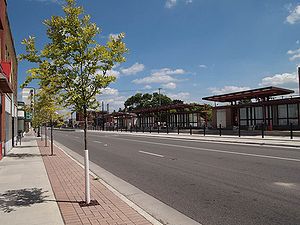
Tree trenches and tree boxes are a type of bioretention practice and are therefore an excellent stormwater treatment practice due to the variety of pollutant removal mechanisms including vegetative filtering, settling, evaporation, infiltration, transpiration, biological and microbiological uptake, and soil adsorption. Tree trenches and tree boxes can be designed as an effective infiltration / recharge practice, particularly when parent soils have high permeability (> ~ 0.3 inches per hour).
The following design considerations can improve the water quality benefits of tree trenches.
- Maximize infiltration by designing with the maximum ponded depth that can be infiltrated in 48 hours, up to 1.5 feet (to protect vegetation). Where space allows, surface area can also be increased.
- Utilize multiple bioretention practices in series.
- On lower permeability soils where an underdrain is used, raise the underdrain to the maximum extent possible, allowing water stored in the engineered media below the underdrain to drain in 48 hours. Use an upturned elbow in underdrained systems.
- For bioinfiltration (bioretention without an underdrain), use a high organic matter media to maximize pollutant removal.
- For biofiltration (bioretention with an underdrain), use a media mix that does not export phosphorus or use an amendment to attenuate phosphorus.
See Calculating credits for tree trenches and tree boxes
Permeable Pavement
Permeable pavement reduces the concentration of some pollutants either physically (by trapping it in the pavement or soil), chemically (bacteria and other microbes can break down and utilize some pollutants), or biologically (plants that grow in-between some types of pavers can trap and store pollutants)(5). Permeable pavement functioning as an infiltration practice (no underdrain) effectively treats most pollutants, including dissolved pollutants. When an underdrain is employed, permeable pavement is effective at removing solids and pollutants attached to those solids. Additionally, permeable pavements can reduce the need for road salt.
The following design considerations may improve the water quality benefits of permeable pavement.
- Ensure the subgrade is flat. Since roads are typically sloped, utilize terracing in the subgrade to achieve flat slopes. See page 5 of the North Carolina design guidance.
- Incorporate signage into the design to ensure maintenance activities do not affect the infiltration properties of the pavement.
- Design to maximize retention time and prevent short-circuiting. Storage may be increased by use of geotextile subgrades. An example is presented by Nnadi et al, (2014).
- Plan for the expected loading on the permeable pavement and ensure capabilities and reduce compaction or clogging
- Use in conjunction with other treatments to establish a treatment train or reuse water on site
- Some research has been conducted into use of geotextiles and other amendments for enhancing water quality treatment. See Ostrom and Davis (2019) and Nnadi et al. (2014).
See Calculating credits for permeable pavement
Green Roofs
Green roofs provide stormwater treatment benefits, but because pollutant concentrations are generally low, these benefits are limited. Pollutant removal mechanisms include filtering, evaporation, transpiration, biological and microbiological uptake, and soil adsorption.
Green roofs employ engineered media that is effective at removing solids, most metals, and most organic chemicals. Green roofs are generally not effective at retaining phosphorus because of the organic matter content in the media. They therefore are likely to lose phosphorus during the first years after establishment, but loss may gradually diminish over time. Use of low organic matter media, media that does not leach phosphorus (e.g. peat), or amendments (e.g. iron filings) may minimize or eliminate phosphorus losses from green roofs.
See Calculating credits for green roofs and this technical support document.
Water Re-use and Harvesting
Water re-use and water harvesting facilities can help improve water quality by capturing stormwater runoff and reducing offsite discharges into the storm sewer system and nearby water resources. The nature of stormwater re-use facilities varies widely, thus there is great variability in their effectiveness to remove storm water pollutants. Most water re-use projects have been developed to meet non-potable water demands, such as agriculture, landscape, public parks, irrigation, etc. In these cases, the captured stormwater is removed from the waste stream and prevented from reaching receiving waters. Water re-use systems can be used to create or enhance wetlands and riparian (stream) habitats for streams that have been impaired or dried from water diversion, thus enhancing the water quality benefits of these other practices.
The following design considerations may enhance the water quality benefits of harvest and reuse systems.
- The designer should consider the project site pollutant sources during design and determine if additional stormwater treatment measures are required for use, what level of pretreatment is needed, and whether first flush diverters are appropriate. For more information on pollutant sources and pretreatment needs see Water quality considerations for stormwater and rainwater harvest and use/reuse. Also see information on Pretreatment.
- The designer should consider first flush diverters in the collection system design to bypass high pollution loads during snowmelt or pollutant laden events when necessary to meet the requirements of the water use. However, first flush diverters should be utilized with caution (Blue Mountain, 2022; Savou, 2022).
- Designer should place the appropriate settlement and solid removal procedures in the treatment train to prevent their entry into the reuse containment system
- Design the site container to maximize capture and storage of runoff and prevent short-circuiting during rainfall events. See Determining the appropriate storage size for a stormwater and rainwater harvest and use/reuse system and Estimating the water balance for a stormwater and rainwater harvest and use/reuse site.
See Calculating credits for stormwater and rainwater harvest and use/reuse
Constructed Ponds and Wetlands
Pollutants are removed from stormwater runoff in a wetland through uptake by wetland vegetation and biota (algae, bacterial), vegetative filtering, soil adsorption, and gravitational settling in the slow moving marsh flow. Volatilization and chemical activity can also occur, breaking down and assimilating a number of other stormwater contaminants such as hydrocarbons. Wetlands effectively remove solids and pollutants associated with solids. They are only moderately effective at removing nitrogen and phosphorus. Some designs or poorly designed and maintained wetlands may export phosphorus. For information on pollutant removal for stormwater wetlands, link to Calculating credits for stormwater wetlands.
CAUTION: Using constructed wetlands for extensive water quality treatment may impair the wetland for other functions, such as habitat.
The following design considerations may improve the water quality benefits of constructed ponds and wetlands (Balderas-Guzman et al., 2018)
- Distribute constructed wetlands systemically throughout a watershed to increase potential for delivering networked benefits
- Design to maximize retention time and prevent short-circuiting
- Create ecological diversity within the wetland to expose water to a variety of conditions where different treatment processes can take place
- Create shallow zones were water will come into contact with plant roots and microbes and deeper zones where anaerobic processes can take place
- Utilize a length to width ratio of 20:1
- Construct multiple wetland cells
- Ensure adequate pretreatment to minimize pollutant loading that might impair other benefits, such as habitat
See Calculating credits for stormwater wetlands
Swale with Check Dam (with and without underdrain)
Water quality benefits of swales depends on the type of swale (Jamil, 2009). See Terminology for swales.
- Dry swales: Water quality benefits of dry swales primarily depend on the presence or absence of check dams and underlying soils. When impermeable check dams are used on permeable soils (hydrologic group A or B soils), swales act as infiltration practices and provide water quality benefits similar to other infiltration practices. If check dams are permeable, swales provide water quality treatment through sedimentation processes. When check dams are absent, swales may provide some filtration of water by vegetation and some infiltration if underlying soils are permeable.
- Wet swales: Wet swales are generally ineffective for water quality treatment.
- Step pools: Similar to dry swales, step pools can provide effective water quality treatment when impermeable check dams are employed on permeable soils.
The following design considerations may improve the water quality benefits of swales. (Guzman et al., 2018; (Stagge et al., 2012; Purvis et al., 2018).
- If underlying soils are permeable (HSG A or B), incorporate impermeable check dams into the design to promote infiltration. For wet swales incorporate permeable check dams to slow water movement and enhance filtration of solids.
- For infiltration swales (swales without an underdrain), use a high organic matter media to maximize pollutant removal
- Utilize side slopes as pretreatment by incorporating appropriate vegetation and geometry (e.g. dense grass, increased surface roughness, gentler and longer slopes)
- Select vegetation with dense root systems
- For swales (swales with an underdrain), use a media mix that does not export phosphorus or use an amendment to attenuate phosphorus.
See Calculating credits for dry swale (grass swale), Calculating credits for wet swale (wetland channel), and Calculating credits for high-gradient stormwater step-pool swale.
Infiltration practices
Several practices can be designed as either filtration or infiltration practices. These include bioretention, permeable pavement, and tree trenches without underdrains, swales with impermeable check dams, and harvest and reuse systems. These practices are discussed above. If the practice is designed to infiltrate stormwater runoff, water quality benefits of the practices are excellent as infiltration removes 100 percent of the pollutants captured by the practice. However, infiltration practices should be designed to avoid potential groundwater contamination, such as infiltration practices located on coarse-textured soils with groundwater tables near the land surface, or infiltrating runoff with high concentrations of potentially mobile pollutants. See the constraints section on this page.
References
- Balderas-Guzman, C., H. Nepf, and A. M. Berger. 2018. Design Guidelines for Urban Stormwater Wetlands.
- Berndtsson, J.C., L. Bengtsson, and K. Jinno. 2009. Runoff water quality from intensive and extensive vegetated roofs. Ecological Engineering, Volume 35, Issue 3, Pages 369-380.
- Blue Mountain. Why use First Flush Diverters?. Accessed November 15, 2022.
- Davis, A.P. 2007. Performance of Bioretention: Water Quality. Environmental Engineering ScienceVol. 24, No. 8. https://doi.org/10.1089/ees.2006.0190.
- Guzman, C.B., S.R. Cohen, M.L. Machado, and T. Swingle. 2018. Island topographies to reduce short-circuiting in stormwater detention ponds and treatment wetlands. Ecological Engineering 117:182. DOI:10.1016/j.ecoleng.2018.02.020
- Jamil, N.E.E. 2009. FIELD EVALUATION OF HYDROLOGIC AND WATER QUALITY BENEFITS OF GRASS SWALES WITH CHECK DAMS FOR MANAGING HIGHWAY RUNOFF. M.S. Thesis, University of Maryland.
- OConnor, T., P. Culligan, T. Carson, S. Gaffin, R. Gibson, R. Hakimdavar, D. Hsueh, N. Hunter, D. Marasco, AND W. McGillis. 2014. Evaluation of Green Roof Water Quantity and Quality Performance in an Urban Climate. U.S. EPA Office of Research and Development, Washington, DC, EPA/600/R-14/180.
- Purvis, R.A., R.J. Winston, W.F. Hunt, B. Lipscomb, K. Narayanaswamy, A. McDaniel, M.S. Lauffer, and S. Libes. 2018. Evaluating the Water Quality Benefits of a Bioswale in Brunswick County, North Carolina (NC), USA. Water 2018, 10(2), 134; https://doi.org/10.3390/w10020134.
- United States EPA. 2013. Stormwater to Street Trees: Engineering Urban Forests for Stormwater Management. EPA 841-B-13-001.
- Savou, J. To First Flush, or not to First Flush. BlueBarrel Rainwater Catchment Systems.
- Selbig, B.R. 2019. Evaluating the potential benefits of permeable pavement on the quantity and quality of stormwater runoff.
- Stagge, J.H., A.P. Davis, E. Jamil, and H. Kim. 2012. Performance of grass swales for improving water quality from highway runoff. Water Research, Volume 46, Issue 20, Pages 6731-6742. https://doi.org/10.1016/j.watres.2012.02.037.
- United States EPA. Soak up the Rain - Permeable Pavement. Website accessed November 16, 2022.
- United States EPA. 2009. Storm Water Technology Fact Sheet - Sand Filters. EPA 832-F-99-007.
This page was last edited on 5 December 2022, at 17:35.


